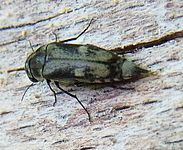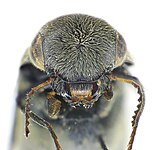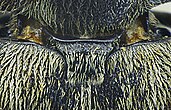Broad-headed sting beetle
| Broad-headed sting beetle | ||||||||||||
|---|---|---|---|---|---|---|---|---|---|---|---|---|

Broad-headed sting beetle Tomoxia bucephala |
||||||||||||
| Systematics | ||||||||||||
|
||||||||||||
| Scientific name | ||||||||||||
| Tomoxia bucephala | ||||||||||||
| ( Costa , 1854) |
The broad-headed sting beetle ( Tomoxia bucephala , Syn .: Tomoxia biguttata ) is a beetle from the family of the sting beetles (Mordellidae), which is related to the black beetle . The genus Tomoxia has traditionally been listed as a subgenus of the genus Mordella and is only represented in Europe by the one species Tomoxia bucephala .
The scientific generic name “Tomoxia” (from ancient Greek τομή, “tomē” “cut” and ὀξύς “oxýs”, “sharp”) and the species name bucephala , also from the Greek, (βοῦς “bōūs” “ox” and κεφαλή “kephalē "" Head ") express that the broad head is sharply set off against the rest of the body.
Characteristics of the beetle
The narrow and curved beetle has a length of 5.5 to 8.5 millimeters if you measure from the upper jaws with protruding head to the end of the wing covers in the usual way with the sting beetles . The spiky end of the abdomen ( pygidium ) behind the wing covers , from which the sting beetles owe their name, is relatively short in the broad-headed sting beetle and only increases the total length by about two millimeters. The black body color is largely covered by the hair, so that the beetle looks gray-brown with whitish spots.
The head is pulled down in the event of danger, the mouthparts then point backwards at an angle. The upper jaw ends in two teeth (Fig. 4). The jaw probes are four-parted, the end part broadly ax-shaped (Fig. 8B). The lip buttons are also four-link, the end link is inverted pear-shaped (Fig. 8A). The large, round eyes are finely faceted and have short hairs (clearly visible in Fig. 2). They stand at the widest part of the head and reach its rear edge (Fig. 5). The eleven-link antennae (Fig. 7) are very thin and weakly serrated from the fifth link on. The last antenna segment is stranded at the tip.
The pronotum (Fig. 5) is bordered up to the front angles. It is more hairy along the sides and at the base to the right and left of the center and looks light gray there.
The elytra show through lighter hair shortly behind the center near the side edge, a mostly clear round whitish spot. This explains the name bipunctatus . The points lie in an elongated dark area, the rest of the elytra is usually a little paler hairy than the spots (Fig. 1). The elytra leave most of the pygidium uncovered. The short pygidium is truncated at the back and its length is about a third of the length of the elytra. Its root is also densely hairy. The large label is wider than it is long and trapezoidal (Fig. 6).
The sting beetle family belongs to the heteromeric family group (old gr. Different parts), which have five-limbed tarsi on the two front pairs of legs , while the tarsi of the hind legs are only four-limbed. In addition, the tarsi of the broad-headed sting beetle have very different shapes (Fig. 9). The tarsi of the front legs (Fig. 9 A) are delicate, the tarsi of the middle pair of legs (Fig. 9 B) are very elongated, the hind tarsi (Fig. 9 C), especially the first limb, are robust and rectangular in cross-section. The claw links are long, the claws serrated below and provided with a bristle-shaped appendage at the base, not toothed like a comb (best visible in Fig. 9 C at full resolution). The penultimate tarsal phalanx is not lobed or bulged on the first two pairs of legs, but is cut straight off. The rear rail is notched just before the end and parallel to it on the upper side (Fig. 10, the apical notch, yellow below). Moreover, it is like the first Tarsenglied notched very fine longitudinal (Dorsalkerb ( m. ) In Fig. 10 below in green).
biology
The species is found in deciduous and mixed forests on dead wood and on flowers. The larvae develop in hardwood that is still firm but has already become fungus ( beech , oak , willow , poplar , and occasionally spruce ). The adults eat pollen ( hawthorn , dogwood and others).
distribution
The species occurs in almost all European countries, but is absent in the Baltic States , south-east Europe ( Greece , Albania , Macedonia ) as well as Ireland , Belgium and in the south-east of the European part of Russia . The distribution area also extends over parts of Asia .
literature
- Heinz joy , Karl Wilhelm Harde , Gustav Adolf Lohse (ed.): The beetles of Central Europe . tape 8 . Teredilia Heteromera Lamellicornia . Elsevier, Spektrum, Akademischer Verlag, Munich 1969, ISBN 3-8274-0682-X .
- Klaus Koch : The Beetles of Central Europe Ecology . 1st edition. tape 2 . Goecke & Evers, Krefeld 1989, ISBN 3-87263-040-7 .
Individual evidence
- ^ A b Edmund Reitter : Fauna Germanica, the beetles of the German Empire III. Volume, KGLutz 'publishing house, Stuttgart 1911
- ↑ a b Tomoxia bucephala in Fauna Europaea. Retrieved September 23, 2012
- ↑ Gustav Jäger (Ed.): CG Calwer’s Käferbuch . K. Thienemanns, Stuttgart 1876, 3rd edition
- ↑ Tomoxia at Fauna Europaea. Retrieved September 23, 2012
- ↑ Sigmund Schenkling: Explanation of the scientific beetle names (genus)
- ↑ Sigmund Schenkling: Explanation of the scientific beetle names (species)
- ↑ Klaus Koch : Die Käfer Mitteleuropas Ökologie . 1st edition. tape 2 . Goecke & Evers, Krefeld 1989, ISBN 3-87263-040-7 .










